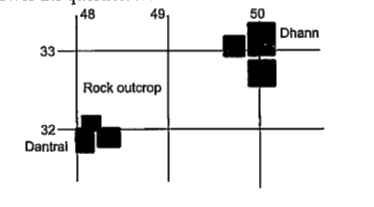Give examples of (a) igneous and (b) sedimentary rocks. What is the origin of (a) igneous rocks and (b) sedimentary rocks ?
Step-by-Step Text Solution:
1. Identify the Types of Rocks:
- The question asks for examples of two types of rocks: igneous and sedimentary.
2. Examples of Igneous Rocks:
- Some common examples of igneous rocks include:
- Granite
- Scoria
- Pumice
- Obsidian
3. Origin of Igneous Rocks:
- Igneous rocks are formed from molten rock known as magma. When this magma cools and solidifies, it transforms into igneous rock. Thus, the origin of igneous rocks is the cooling and solidification of magma.
4. Examples of Sedimentary Rocks:
- Some common examples of sedimentary rocks include:
- Sandstone
- Limestone
- Shale
- Gypsum
- Conglomerate
5. Origin of Sedimentary Rocks:
- Sedimentary rocks are formed through the accumulation and compaction of sediments. These sediments can originate from the weathering of existing rocks or from the precipitation of minerals from water. Over time, layers of these sediments accumulate and compact to form sedimentary rocks.
Summary:
- Examples of Igneous Rocks: Granite, Scoria, Pumice, Obsidian
- Origin of Igneous Rocks: Formed from the cooling and solidification of magma.
- Examples of Sedimentary Rocks: Sandstone, Limestone, Shale, Gypsum, Conglomerate
- Origin of Sedimentary Rocks: Formed from the accumulation and compaction of sediments, which can come from weathered rocks or precipitated minerals from water.
---
- The question asks for examples of two types of rocks: igneous and sedimentary.
- Some common examples of igneous rocks include:
- Granite
- Scoria
- Pumice
- Obsidian
- Igneous rocks are formed from molten rock known as magma. When this magma cools and solidifies, it transforms into igneous rock. Thus, the origin of igneous rocks is the cooling and solidification of magma.
- Some common examples of sedimentary rocks include:
- Sandstone
- Limestone
- Shale
- Gypsum
- Conglomerate
- Sedimentary rocks are formed through the accumulation and compaction of sediments. These sediments can originate from the weathering of existing rocks or from the precipitation of minerals from water. Over time, layers of these sediments accumulate and compact to form sedimentary rocks.
- Examples of Igneous Rocks: Granite, Scoria, Pumice, Obsidian
- Origin of Igneous Rocks: Formed from the cooling and solidification of magma.
- Examples of Sedimentary Rocks: Sandstone, Limestone, Shale, Gypsum, Conglomerate
- Origin of Sedimentary Rocks: Formed from the accumulation and compaction of sediments, which can come from weathered rocks or precipitated minerals from water.
Topper's Solved these Questions
- GENERAL PRINCIPLES AND PROCESS OF ISOLATION OF ELEMENTSBOOK - CENGAGE CHEMISTRY ENGLISHCHAPTER - GENERAL PRINCIPLES AND PROCESS OF ISOLATION OF ELEMENTSEXERCISE - Solved Example
25 Videos
- GENERAL PRINCIPLES AND PROCESS OF ISOLATION OF ELEMENTSBOOK - CENGAGE CHEMISTRY ENGLISHCHAPTER - GENERAL PRINCIPLES AND PROCESS OF ISOLATION OF ELEMENTSEXERCISE - Exs 1.1 (Subjective)
25 Videos
- ELECTROCHEMISTRYBOOK - CENGAGE CHEMISTRY ENGLISHCHAPTER - ELECTROCHEMISTRYEXERCISE - Archieves Subjective
35 Videos
- GRIGNARD REAGENTS AND ORGANOMETALLIC REAGENTSBOOK - CENGAGE CHEMISTRY ENGLISHCHAPTER - GRIGNARD REAGENTS AND ORGANOMETALLIC REAGENTSEXERCISE - Exercises Archives (Linked Comprehension)
1 Videos
Similar Questions
Knowledge Check

What is the four figure grid reference of rock outcrop ?A4832B4933C3248D3349
The first organisms to colonise rocks are
View SolutionName the Indian soil which is formed due to the wekthering of basic igneous rocks.
View SolutionWhat is the difference between a rock and a mineral ?
View SolutionWhat is the difference between a rock and a mineral ?
View SolutionWhat is the difference between a rock and a mineral ?
View SolutionMost of the fossils occur in rocks
View SolutionLichens growing on rocks are called
View Solution
